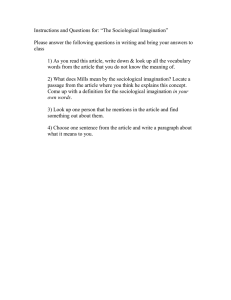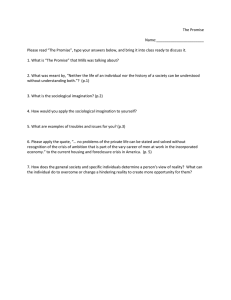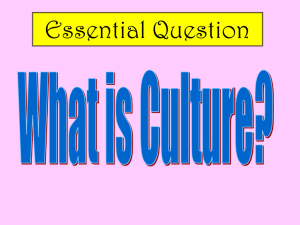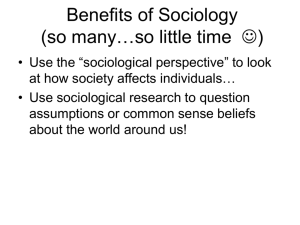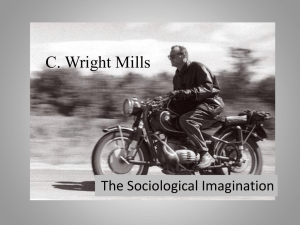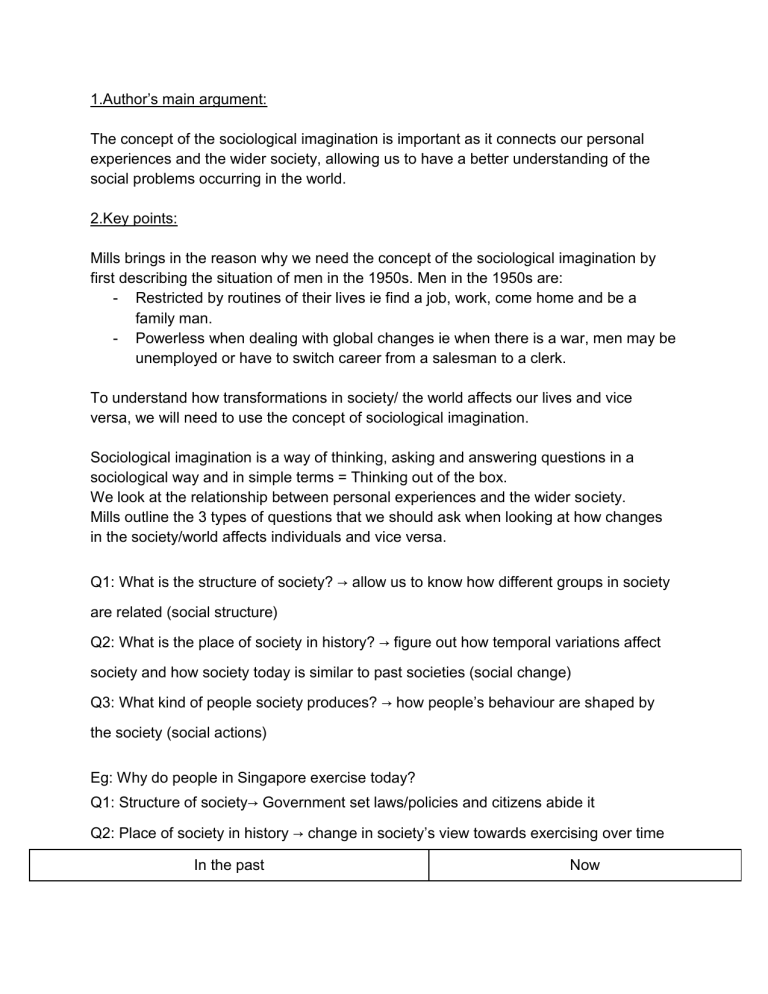
1.Author’s main argument: The concept of the sociological imagination is important as it connects our personal experiences and the wider society, allowing us to have a better understanding of the social problems occurring in the world. 2.Key points: Mills brings in the reason why we need the concept of the sociological imagination by first describing the situation of men in the 1950s. Men in the 1950s are: - Restricted by routines of their lives ie find a job, work, come home and be a family man. - Powerless when dealing with global changes ie when there is a war, men may be unemployed or have to switch career from a salesman to a clerk. To understand how transformations in society/ the world affects our lives and vice versa, we will need to use the concept of sociological imagination. Sociological imagination is a way of thinking, asking and answering questions in a sociological way and in simple terms = Thinking out of the box. We look at the relationship between personal experiences and the wider society. Mills outline the 3 types of questions that we should ask when looking at how changes in the society/world affects individuals and vice versa. Q1: What is the structure of society? → allow us to know how different groups in society are related (social structure) Q2: What is the place of society in history? → figure out how temporal variations affect society and how society today is similar to past societies (social change) Q3: What kind of people society produces? → how people’s behaviour are shaped by the society (social actions) Eg: Why do people in Singapore exercise today? Q1: Structure of society→ Government set laws/policies and citizens abide it Q2: Place of society in history → change in society’s view towards exercising over time In the past Now Have no choice but to “exercise” through work as many of Government promoting work life balance → them are construction workers and they have to carry more leisure time to exercise construction materials so as to build buildings. People are more educated, wants to keep fit so as to have a longer life expectancy. Media portrays individuals that are slim and fit as the “norm”, encourages people to follow celebrities so people exercise. Q3: Kinds of people society produce → People are more health conscious after the media informs them about the negative consequences of not exercising ie obesity, high blood pressure etc. People’s behaviour are influenced by the society. In the example above as to why people exercise, instead of personal reasons such as keeping fit, lose weight etc. It has been linked to the wider society through reasons such as influence from government policies, education and the media which is what it meant by sociological imagination. In order to allow us to deeper understand individual circumstances( biography) connects to a larger institutional context (history), Mills introduced the concept of personal “troubles” and public “issues”. “Troubles” are just your own problems and “issues” are problems belonging to the larger social structure. Mills give the example of divorce. So if 1 couple divorce, it is a “trouble”. If half the population divorce, it is a “issue”. As personal problems and social structures are related, Mills state that there is a relation between personal values and public issues and how a society does or does not support an individuals’ values. People with values supported by the society = wellbeing People with values that are unsupported by the society = crisis People with values that are neither supported or unsupported by the society = indifferences Eg: Gender discrimination; LGBT community in the world today People with values supported → couples (1 male 1 female) enjoy wellbeing People with values that are unsupported → LGBT community People with values that are neither supported or unsupported → people who hold neutral stands towards same sex marriage 3.Important theories and concepts: - Sociological Imagination and how to apply them - Personal “troubles” and public “issues” and their relationship 4:What should we take away from this chapter: - Although the article is published in the 1950s, Mills’ concept of the sociological imagination is still useful today when looking at social problems in a society (the example of exercise) as we can understand social problems at a deeper depth and wider scope. - The concept of “troubles” and public “issues” are relevant today (the example of LGBT community) Other examples such as unemployment, Outbreak of diseases also display the concept of “troubles” and “issues”. - However, other than the sociological imagination perspective when looking at social problems for depth and scope, we can also use other theoretical perspectives such as conflict theory, symbolic interactionism, etc. Different theories or concepts may be more applicable than sociological imagination when viewing a particular social problem. Ie conflict theory may be more applicable when looking at inequality or class divide.

